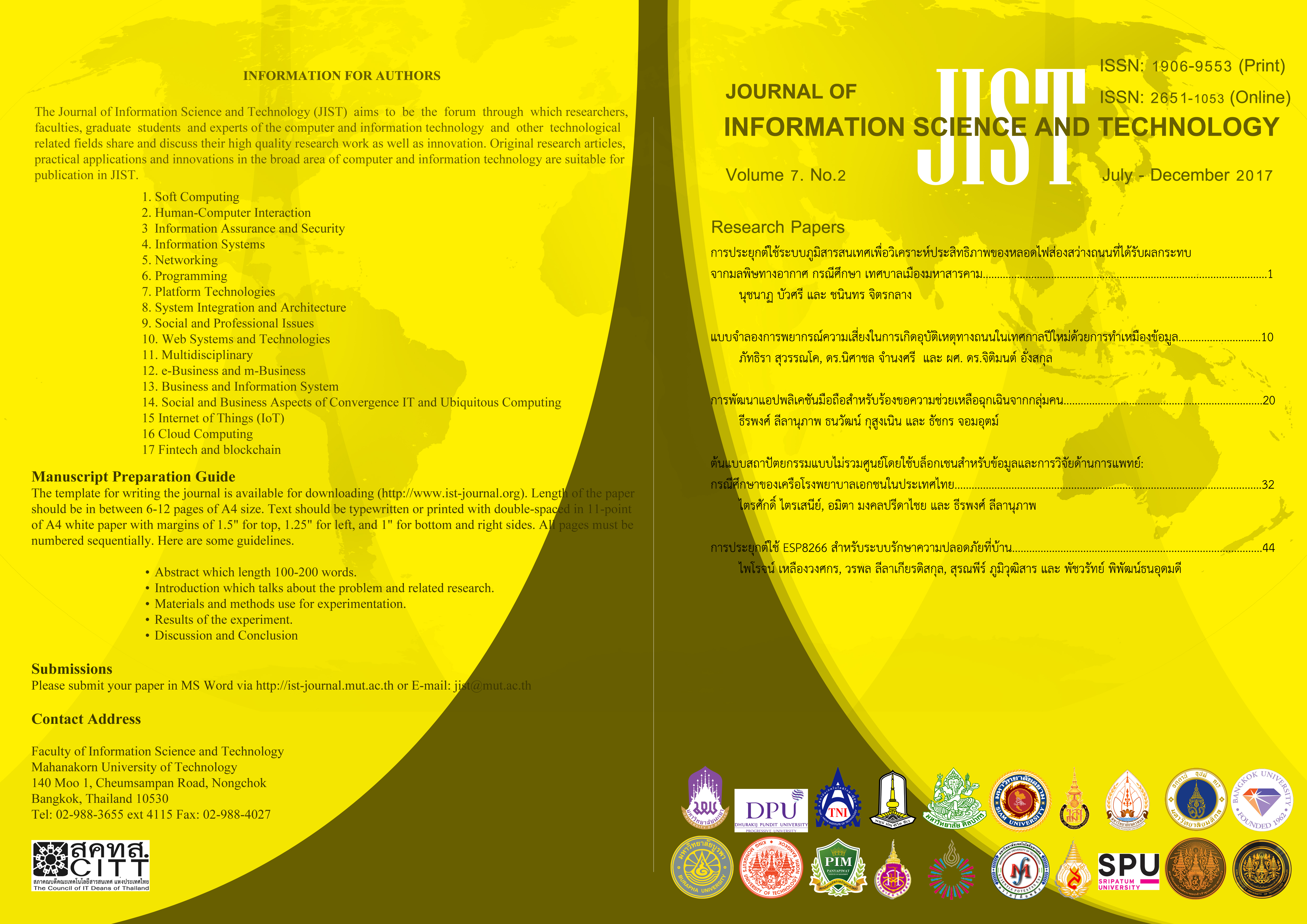A Prototype of Decentralized Architecture Using Blockchain for Medical Records and Research: A Case Study of a Private Hospital Group in Thailand
Main Article Content
Abstract
- In Information Technology (IT), Blockchain does not only benefit economic but also greatly benefits other domains, such as scientific, political and medical. It provides a new solution with lower-cost, higher-scalability and greater-security for storing and controlling access to massive data. In medical domain, shifting from typical paper-based to electronic health records results in an increasing number of health data. Such health data, also collected by today’s personal ubiquitous computing devices (e.g., smart-watches and phones), are very useful for preventive and proactive medical research. Therefore, health IT systems require a new architecture to record medical information. This article presents the design of a prototype of decentralized architecture for medical record using private Blockchain. As a case study of this research, the largest group of private hospitals in Thailand has been collaborating with us in providing their initial requirements for the design and implementation. Our design work involves the use of a private Blockchain and its smart contract as an access control manager to medical records. Different tools for Blockchain technologies are also reviewed. This article poses a next step towards the proof-of-concept in implementing Blockchain in Thailand as Blockchain-as-a-service (BaaS) for medical records.
Article Details
This work is licensed under a Creative Commons Attribution-NonCommercial-NoDerivatives 4.0 International License.
I/we certify that I/we have participated sufficiently in the intellectual content, conception and design of this work or the analysis and interpretation of the data (when applicable), as well as the writing of the manuscript, to take public responsibility for it and have agreed to have my/our name listed as a contributor. I/we believe the manuscript represents valid work. Neither this manuscript nor one with substantially similar content under my/our authorship has been published or is being considered for publication elsewhere, except as described in the covering letter. I/we certify that all the data collected during the study is presented in this manuscript and no data from the study has been or will be published separately. I/we attest that, if requested by the editors, I/we will provide the data/information or will cooperate fully in obtaining and providing the data/information on which the manuscript is based, for examination by the editors or their assignees. Financial interests, direct or indirect, that exist or may be perceived to exist for individual contributors in connection with the content of this paper have been disclosed in the cover letter. Sources of outside support of the project are named in the cover letter.
I/We hereby transfer(s), assign(s), or otherwise convey(s) all copyright ownership, including any and all rights incidental thereto, exclusively to the Journal, in the event that such work is published by the Journal. The Journal shall own the work, including 1) copyright; 2) the right to grant permission to republish the article in whole or in part, with or without fee; 3) the right to produce preprints or reprints and translate into languages other than English for sale or free distribution; and 4) the right to republish the work in a collection of articles in any other mechanical or electronic format.
We give the rights to the corresponding author to make necessary changes as per the request of the journal, do the rest of the correspondence on our behalf and he/she will act as the guarantor for the manuscript on our behalf.
All persons who have made substantial contributions to the work reported in the manuscript, but who are not contributors, are named in the Acknowledgment and have given me/us their written permission to be named. If I/we do not include an Acknowledgment that means I/we have not received substantial contributions from non-contributors and no contributor has been omitted.
References
2. D. Palmer, “Blockchain Startup to Secure 1 Million e-Health Records in Estonia” [online], Retrieved from https://www.coindesk.com/blockchain-startup-aims-to-secure-1-million-estonian-health-records, Mar. 2016.
3. M. Swan, “Blockchain: Blueprint for a New Economy”, O'Reilly Media, Inc., pp. ix – xi, 2015.
4. S. Raval, “Decentralized Applications: Harnessing Bitcoin's Blockchain Technology”, O'Reilly Media, Inc., pp. 3 - 38, 2016.
5. T. R. Peltier, “Information Security Fundamentals”, 2nd edition, pp. 29 – 42, 2014.
6. V. Buterin , “Merkling in Ethereum” [online], Retrieved from https://blog.ethereum.org/2015/11/15/merkling-in-ethereum/, Dec. 2015
7. V. Morabito, “Business Innovation Through Blockchain”, pp. 10 - 13, 2017
8. V. Butein, “A Next Generation Smart Contract & Decentralized Application Platform” [online], Retrieved from https://github.com/ethereum/wiki/wiki/White-Paper, Dec. 2017
9. M. Massé, “REST API Design Rulebook”, O'Reilly Media, Inc., pp. 5 - 33, 2011
10. The go-ehereum Authors, “Go Ethereum” [online], Retrieved from https://github.com/ethereum/go-ethereum


